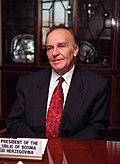Bosnian War
The Bosnian War is the generally accepted name for an international military conflict in the area of Bosnia and Herzegovina, which lasted from April 6th 1992 to December 14th 1995, between Serbia and Montenegro, the Republic of Bosnia and Herzegovina and the Croatia. This war is often appointed and as The aggression on Bosnia and Herzegovina and Civil War in Bosnia and Herzegovina. Bosnia and Herzegovina formally indicted Serbia and Montenegro for genocide before the International Court of Justice. The Court 21st February 2007 published a judgment in which he concluded that the war had an international character.[9][10][11][12]
| Bosnian War | ||||||||
|---|---|---|---|---|---|---|---|---|
| Part of the Yugoslav Wars | ||||||||
 The Executive Council Building burns after being hit by tank fire in Sarajevo May 1992; Ratko Mladić with Army of Republika Srpska officers; a Norwegian UN soldier in Sarajevo. | ||||||||
| ||||||||
| Belligerents | ||||||||
|
1992: |
1992: | |||||||
|
1992–94: |
1992–94: |
1992–94: Supported by: | ||||||
|
1994–95: |
1994–95: Supported by: | |||||||
| Commanders and leaders | ||||||||
|
|
(HVO Chief of Staff) …and others |
| ||||||
| Strength | ||||||||
|
ARBiH: 110,000 troops 100,000 reserves 40 tanks 30 APCs[1] |
HVO: 45,000–50,000 troops[2] 75 tanks 50 APCs 200 artillery pieces[3] HV: 15,000 troops[4] |
VRS: 80,000 troops 300 tanks 700 APCs 800 artillery pieces[5] AP Western Bosnia: 4,000–5,000 troops[6] | ||||||
| Casualties and losses | ||||||||
|
30,521 soldiers killed 31,583 civilians killed[7] |
6,000 soldiers killed 2,484 civilians killed[7] |
21,173 soldiers killed 4,179 civilians killed[7] | ||||||
| additional 5,100 killed whose ethnicity and status are unstated[8] | ||||||||
|
a ^ b ^ | ||||||||
It is estimated that in the nearly four-year war killed as many as 200,000 people, while over 2,000,000 people had to leave their homes. According to more recent reports, the war killed around 94,000 inhabitants, and displaced about 1,800,000 people. The war was caused by a complex combination of the general political, social and security crisis in the country, which followed the end of the Cold War and the fall of the socialist system in Yugoslavia. The war ended with the signing Peace Agreement in Dayton, Ohio on 21 November 1995.[source?]
Bosnian War Media
Alija Izetbegović during his visit to the United States in 1997
Goran Jelisić shooting a Bosniak in Brčko in 1992
Bosniak civilian detainees mainly from the Prijedor region, in Manjača camp.
Model of the Čelebići camp, near Konjic, presented as evidence in the Mucić et al. trial
Map of Operation Corridor 92, fought between the VRS and the HV-HVO
References
- ↑ Ramet 2010, p. 130.
- ↑ Christia 2012, p. 154.
- ↑ Ramet 2006, p. 450.
- ↑ Mulaj 2008, p. 53.
- ↑ Finlan 2004, p. 21
- ↑ Ramet 2006, p. 451.
- ↑ 7.0 7.1 7.2 "Spolna i nacionalna struktura žrtava i ljudski gubitci vojnih formacija (1991–1996)". Prometej.
- ↑ "After years of toil, book names Bosnian war dead". Reuters. Archived from the original on 2013-07-21. Retrieved 2018-05-28.
- ↑ "ICTY: Conflict between Bosnia and Herzegovina and the Federal Republic of Yugoslavia". Retrieved 25 April 2015.
- ↑ "ICTY: Conflict between Bosnia and Croatia".
- ↑ "ICJ: The genocide case: Bosnia v. Serbia – See Part VI – Entities involved in the events 235–241" (PDF). Archived from the original (PDF) on 1 March 2011. Retrieved 25 April 2015.
- ↑ "ICTY: The attack against the civilian population and related requirements". Archived from the original on 19 February 2009. Retrieved 25 April 2015.








